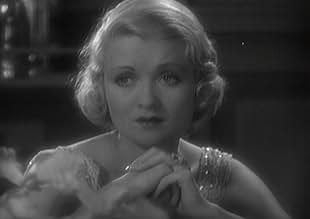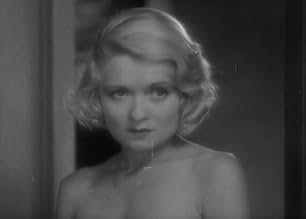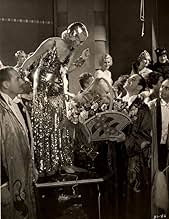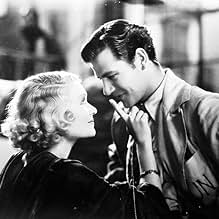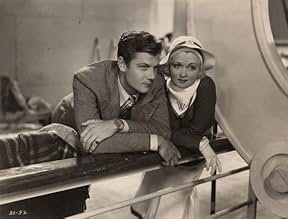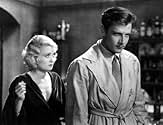Ajouter une intrigue dans votre langueYoung Valerie models for an American painter who tries to make a future in Paris and they fall in love.Young Valerie models for an American painter who tries to make a future in Paris and they fall in love.Young Valerie models for an American painter who tries to make a future in Paris and they fall in love.
- Réalisation
- Scénario
- Casting principal
Emile Chautard
- Doorman
- (non crédité)
Albert Conti
- Strangeways Party Guest
- (non crédité)
Carrie Daumery
- Strangeways Party Guest
- (non crédité)
George Davis
- Charles - Dick's Butler
- (non crédité)
Julia Swayne Gordon
- Mrs. Strangeways
- (non crédité)
George Irving
- Doctor
- (non crédité)
Dolores Murray
- Queen at the Ball
- (non crédité)
Tom Ricketts
- Elderly Strangeways Party Guest
- (non crédité)
Marshall Ruth
- Strangeways Party Guest
- (non crédité)
Avis à la une
Joel McCrea plays an American artist living in Paris. He hires a woman (Constance Bennett) to be his nude model and eventually they fall in love. However, when he learns she has a tawdry past, he runs off to brood. Later, at debaucherous party, they meet once again. Soon, he asks her to marry him--she suggests they cohabitate to see if he really wants her. When the scandal of this relationship reaches his rich parents' ears, his mother schemes to pull the two lovers apart. However, in a strange scene, McCrea's on-screen father says that he heartily approves of the pair living together and wishes them the best! What happens next? See this odd film for yourself to find out for yourself.
If you haven't guessed, this film is CLEARLY an example of Pre-Code sensibilities. What I mean by that is that up until mid-1934, Hollywood's sense of morality was FAR looser than most folks would believe today. This was especially true from 1930-34--where adultery, premarital sex, violence, foul language, abortion and partial nudity were not terribly uncommon on the screen. But this moral code was not in line with America and soon folks started avoiding movies and ticket sales dropped. Soon, to lure back families, a strengthened Production Code was enforced--and films became, at times, a bit over-sanitized--but very family-friendly. Because of all this, there is zero chance this film could have been made after the Code was enforced--at least not without LOTS of revisions as well as a clear message that such immorality MUST be punished. But here in "The Common Law", the villains are NOT people who flaunt morality but the narrow-minded folks who don't approve and who, in some cases, are simply hypocrites! So is it worth seeing? Well, the film is well-acted and interesting. And, I do enjoy seeing many of the Pre-Code films because they are so strange and confusing--and entertaining!! So, I'd say this is very much worth seeing and a fine example of the genre.
If this isn't a plot that screams 'I'm a Pre-Code film!', nothing is!!
If you haven't guessed, this film is CLEARLY an example of Pre-Code sensibilities. What I mean by that is that up until mid-1934, Hollywood's sense of morality was FAR looser than most folks would believe today. This was especially true from 1930-34--where adultery, premarital sex, violence, foul language, abortion and partial nudity were not terribly uncommon on the screen. But this moral code was not in line with America and soon folks started avoiding movies and ticket sales dropped. Soon, to lure back families, a strengthened Production Code was enforced--and films became, at times, a bit over-sanitized--but very family-friendly. Because of all this, there is zero chance this film could have been made after the Code was enforced--at least not without LOTS of revisions as well as a clear message that such immorality MUST be punished. But here in "The Common Law", the villains are NOT people who flaunt morality but the narrow-minded folks who don't approve and who, in some cases, are simply hypocrites! So is it worth seeing? Well, the film is well-acted and interesting. And, I do enjoy seeing many of the Pre-Code films because they are so strange and confusing--and entertaining!! So, I'd say this is very much worth seeing and a fine example of the genre.
If this isn't a plot that screams 'I'm a Pre-Code film!', nothing is!!
The Common Law according to The Films Of Joel McCrea casts Joel for the very first time in white tie and tails, costuming he would get quite used to as his career progressed. Fortunately for him he would never get typecast in them the way Franchot Tone was.
This was also one of four films McCrea would do with Constance Bennett, a number that would qualify them as a screen team of sorts. The Common Law is one of those escapist dramas that Depression Era audiences just loved. This certainly showed a lifestyle that they dare not even dream about.
Joel is a rich young man who has gone to Paris to sow a few wild oats and play at being a Bohemian artist. While there he meets up with Constance Bennett another expatriate American who is living as kept mistress to Lew Cody, a really smarmy Frenchman. But she quarrels with Cody and hires out to McCrea as an artist's model. Naturally the two of them click.
But Joel's got a society sister in Hedda Hopper who is scandalized by such goings on. She'll break up McCrea and Bennett and save the family name and honor as she conceives it is.
The Common Law refers of course to marriage without benefit of clergy or at least civil sanction. This PreCode film while not condemning common law relationships does say women are better protected with a marriage license. An attitude easily understood today.
Robert Williams who later made such a hit in Frank Capra's Platinum Blonde has a supporting role as an perpetually inebriated playboy friend of McCrea's. His performance in this film confirms what a tragic loss he was to the big screen.
The Common Law is far more modern than a few films of today are even, definitely worth a look.
This was also one of four films McCrea would do with Constance Bennett, a number that would qualify them as a screen team of sorts. The Common Law is one of those escapist dramas that Depression Era audiences just loved. This certainly showed a lifestyle that they dare not even dream about.
Joel is a rich young man who has gone to Paris to sow a few wild oats and play at being a Bohemian artist. While there he meets up with Constance Bennett another expatriate American who is living as kept mistress to Lew Cody, a really smarmy Frenchman. But she quarrels with Cody and hires out to McCrea as an artist's model. Naturally the two of them click.
But Joel's got a society sister in Hedda Hopper who is scandalized by such goings on. She'll break up McCrea and Bennett and save the family name and honor as she conceives it is.
The Common Law refers of course to marriage without benefit of clergy or at least civil sanction. This PreCode film while not condemning common law relationships does say women are better protected with a marriage license. An attitude easily understood today.
Robert Williams who later made such a hit in Frank Capra's Platinum Blonde has a supporting role as an perpetually inebriated playboy friend of McCrea's. His performance in this film confirms what a tragic loss he was to the big screen.
The Common Law is far more modern than a few films of today are even, definitely worth a look.
It was said, possibly by David Niven, that Constance Bennett would walk into a room at night to play cards and emerge the next morning looking exactly the same as when she went in. I can believe it. Her beauty, glamor, and freshness are beautifully showcased in "The Common Law" about living and loving (freely) in Paris.
It seems strange that a movie made in 1931 should seem more modern than later films, but we can thank the Hayes code for that. In The Common Law, Bennett, when she's not shacking up with some guy, is a model for an artist, played by boyish Joel McCrea. The two fall in love, go through a breakup and reconcile. She is reticent about getting married. Then McCrea's conniving sister, having heard all the rumors, lures both she and McCrea back to America.
McCrea and Bennett made several films together, and they are a beautiful couple. He's big and wholesome; she's delicate and sophisticated. And of course, they're both incredibly beautiful.
It's always interesting to catch a pre-code movie, and The Common Law is a good one.
It seems strange that a movie made in 1931 should seem more modern than later films, but we can thank the Hayes code for that. In The Common Law, Bennett, when she's not shacking up with some guy, is a model for an artist, played by boyish Joel McCrea. The two fall in love, go through a breakup and reconcile. She is reticent about getting married. Then McCrea's conniving sister, having heard all the rumors, lures both she and McCrea back to America.
McCrea and Bennett made several films together, and they are a beautiful couple. He's big and wholesome; she's delicate and sophisticated. And of course, they're both incredibly beautiful.
It's always interesting to catch a pre-code movie, and The Common Law is a good one.
The common law in "The Common Law" is that a girl is better off married than living in sin. That's a message that the Hays Code censors could have gotten behind, but they never could have approved this 1931 film. In 1931, the Hays Code was in effect but the Production Code Administration and its tough boss Joe Breen, which rigidly enforced the Code, didn't come into existence until 1934. As a result, the studios were able to ignore the Code and get away with sexual themes that would soon become utterly unthinkable. This was a necessity in 1931 because sex brought people into the theaters and the industry was desperate to sell tickets during the depths of the Depression.
Valerie West, an American in Paris, makes her living by being the mistress of a rich American, Dick Cardemon, but she dumps him and starts a career as a nude model. She models for a mediocre but rich American painter named John Neville who falls madly in love with her. However, he evidently assumed she was a virgin because he dumps her when he finds out about Cardemon.
Later Valerie manages to pick up John once again at a very sexy Artists' Ball (there's a still photo of the ball in Vieira, "Sin in Soft Focus" (1999), p. 56). This time Valerie and John decide to live together without getting married, but that causes quite a scandal back home. John's snooty family tries to break them up, but...
The film is a very effective attack on the sexual double standard and on American upper-class conspicuous consumption, snootiness, and prudishness. Attacks on the upper class were quite popular in the early 1930's, given people's desperation in the Depression and the natural tendency to blame the rich for what happened. The film also shows that a smart, spunky, and beautiful girl can make very good despite having engaged in lots of free love (not to mention nude modeling) with rich men. Valerie is not punished for all that sin--in violation of the so-called "compensating values" norm later enforced by Breen and the Production Office. That norm would require that she receive some horrible punishment for engaging in extra-marital sex--but quite to the contrary, Valerie comes out just fine.
The film is an exceptionally interesting example of the kind of movies that were made at the beginning of the sound era but before the curtain came down in 1934 on candid treatments of sexual behavior.
Valerie West, an American in Paris, makes her living by being the mistress of a rich American, Dick Cardemon, but she dumps him and starts a career as a nude model. She models for a mediocre but rich American painter named John Neville who falls madly in love with her. However, he evidently assumed she was a virgin because he dumps her when he finds out about Cardemon.
Later Valerie manages to pick up John once again at a very sexy Artists' Ball (there's a still photo of the ball in Vieira, "Sin in Soft Focus" (1999), p. 56). This time Valerie and John decide to live together without getting married, but that causes quite a scandal back home. John's snooty family tries to break them up, but...
The film is a very effective attack on the sexual double standard and on American upper-class conspicuous consumption, snootiness, and prudishness. Attacks on the upper class were quite popular in the early 1930's, given people's desperation in the Depression and the natural tendency to blame the rich for what happened. The film also shows that a smart, spunky, and beautiful girl can make very good despite having engaged in lots of free love (not to mention nude modeling) with rich men. Valerie is not punished for all that sin--in violation of the so-called "compensating values" norm later enforced by Breen and the Production Office. That norm would require that she receive some horrible punishment for engaging in extra-marital sex--but quite to the contrary, Valerie comes out just fine.
The film is an exceptionally interesting example of the kind of movies that were made at the beginning of the sound era but before the curtain came down in 1934 on candid treatments of sexual behavior.
Joel McCrea was one of the great stars of Twentieth Century movies. I'm not thinking of the Westerns for which he was best known, eventually, but for his light comedy, slapstick, and serious comedy. Not to mention his starring role in one of Hitchcock's very best: "Foreign Correspondent." It seems as if many of the fine directors wanted to work with him. In addition to Hitchcock, Preston Sturges used him -- twice. In "Sullivan's Travels" he is certainly an alter-ego for the writer/director.
Early in his career he did light fare, often paired, as here, with Constance Bennett. He also worked with Miriam Hopkins on several occasions, including the far from comic "These Three." Here he is a painter in Paris. He's from a rich family but he's rebelling. He uses Bennett as a model -- and we see her nude. Not totally but first in her undergarments and then with a towel covering the parts we aren't allowed to see.
So how come he is such a prig when he finds out she is a lady with a past? He sure is, though.
The movie is filled with thudding quips and boring banter. It is fun overall but it definitely could have been a great deal better.
Early in his career he did light fare, often paired, as here, with Constance Bennett. He also worked with Miriam Hopkins on several occasions, including the far from comic "These Three." Here he is a painter in Paris. He's from a rich family but he's rebelling. He uses Bennett as a model -- and we see her nude. Not totally but first in her undergarments and then with a towel covering the parts we aren't allowed to see.
So how come he is such a prig when he finds out she is a lady with a past? He sure is, though.
The movie is filled with thudding quips and boring banter. It is fun overall but it definitely could have been a great deal better.
Le saviez-vous
- AnecdotesThe screenplay was written by John Farrow. Five years later he married actress Maureen O'Sullivan, with whom he had seven children including actress Mia Farrow.
- Citations
John Neville Sr.: You're getting more like your mother every day.
Mrs. Claire Collis: I should think that would make you very happy.
John Neville Sr.: It does. And a little apprehensive.
- ConnexionsFeatured in Thou Shalt Not: Sex, Sin and Censorship in Pre-Code Hollywood (2008)
Meilleurs choix
Connectez-vous pour évaluer et suivre la liste de favoris afin de recevoir des recommandations personnalisées
Détails
- Date de sortie
- Pays d’origine
- Langues
- Aussi connu sous le nom de
- Diosas de Montmartre
- Lieux de tournage
- Paris, France(second unit, background and establishing shots)
- Société de production
- Voir plus de crédits d'entreprise sur IMDbPro
Box-office
- Budget
- 339 000 $US (estimé)
- Durée
- 1h 14min(74 min)
- Couleur
Contribuer à cette page
Suggérer une modification ou ajouter du contenu manquant

